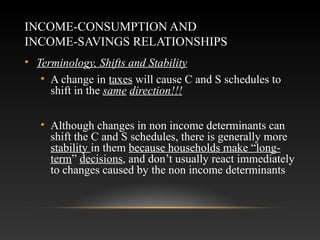Basic macroeconomic relationship lec 1
- 2. CHAPTER OVERVIEW • Identify the consumption & savings functions: what influences them? • What are the non income determinants of consumption & savings? • What influences shifts and movement along a function? • What is the relationship between interest rate & investment? • What causes shifts in the Investment Demand Curve? • What is the multiplier and what effect does it have?
- 3. INCOME-CONSUMPTION AND INCOME-SAVINGS RELATIONSHIPS • By studying the Income & Consumption relationship we are also studying the income & saving relationship • Savings means “not spending” to an economist • Savings = DI (disposable income) – C (consumption) • Although many factors contribute to a nation’s level of consumption or savings, DI is the most significant!!!!!! • 45°line for reference • C = DI on the Line
- 4. INCOME AND CONSUMPTION Consumption (billions of dollars) 10000 9000 05 45° Reference Line C=DI 8000 04 03 7000 00 02 01 C 99 6000 Saving In 1992 5000 4000 3000 83 2000 84 97 91 90 89 88 87 86 85 98 96 95 94 93 92 Consumption In 1992 1000 45° 0 0 2000 4000 6000 8000 10000 Disposable Income (billions of dollars) Source: Bureau of Economic Analysis
- 5. INCOME-CONSUMPTION AND INCOME-SAVINGS RELATIONSHIPS • The Consumption Schedule • Also called the Consumption Function (CF), reflects the direct consumption-disposable income relationship (this is based on historical data) • The CF shows the trend that as households have more DI they have a tendency to spend more; however, households with smaller DI spend a larger portion then households who have a larger DI
- 6. INCOME-CONSUMPTION AND INCOME-SAVINGS RELATIONSHIPS • The Saving Schedule • Shows the amount of savings per DI levels • Households with larger DI can save a greater portion of their DI • What does “dissaving” refer to? • What does the “break-even” income refer to?
- 7. CONSUMPTION AND SAVING (1) (4) (5) (6) (7) Level of Average Average Marginal Marginal (2) Output Propensity Propensity Propensity Propensity Consump(3) And to Consume to Save to Consume to Save tion Saving (S) Income (APC) (APS) (MPC) (MPS) (C) (1) – (2) (GDP=DI) (2)/(1) (3)/(1) Δ(2)/Δ(1) Δ(3)/Δ(1) (1) $370 $375 $-5 1.01 -.01 (2) 390 390 0 1.00 .00 (3) 410 405 5 .99 .01 (4) 430 420 10 .98 .02 (5) 450 435 15 .97 .03 (6) 470 450 20 .96 .04 (7) 490 465 25 .95 .05 (8) 510 480 30 .94 .06 (9) 530 495 35 .93 .07 (10) 550 510 40 .93 .07 .75 .25 .75 .25 .75 .25 .75 .25 .75 .25 .75 .25 .75 .25 .75 .25 .75 .25
- 8. Consumption (billions of dollars) CONSUMPTION AND SAVING 500 C 475 450 425 Saving $5 Billion 400 Consumption Schedule 375 Dissaving $5 Billion Saving (billions of dollars) 45° 370 390 410 430 450 470 490 510 530 550 Disposable Income (billions of dollars) 50 Dissaving Saving Schedule S $5 Billion 25 Saving $5 Billion 0 370 390 410 430 450 470 490 510 530 550
- 9. INCOME-CONSUMPTION AND INCOME-SAVINGS RELATIONSHIPS • What does Average and Marginal Propensities refer to and why are they important? • Average Propensity to Consume (APC) • The % of total income consumed • APC = C / I • Average Propensity to Save (APS) • The % of total income saved • APS = S / I • APS + APC = 1
- 10. INCOME-CONSUMPTION AND INCOME-SAVINGS RELATIONSHIPS • Marginal Propensity to Consume • MPC = the % of “additional” income consumed • MPC = change in C / change in income • Marginal Propensity to Save • MPS = the % of “additional” income saved • MPS = change in S / change in income • MPC + MPS (will always) = 1 MPC and MPS measure slopes
- 12. INCOME-CONSUMPTION AND INCOME-SAVINGS RELATIONSHIPS • Nonincome Determinants of C and S • Although DI is the most important factor for our spending and saving, “nonincome determinants” also influence us. • These are wealth, expectations, real interest rates, household debt and taxes. • Wealth: the value of real and financial assets • When events boost the “value” of existing wealth, households increase their spending and reduce savings.
- 13. INCOME-CONSUMPTION AND INCOME-SAVINGS RELATIONSHIPS • Nonincome Determinants of C and S (continued) • Expectations: household views of their future income and the price level affect their spending and saving decisions • Real interest rates: when real interest rates fall, households tend to borrow more, consume more and save less • Household Debt: households increase consumption by acquiring more debt, up to a point. • Taxation: an increase in taxes will cause a downward shift in both consumption and savings
- 16. INCOME-CONSUMPTION AND INCOME-SAVINGS RELATIONSHIPS • Terminology, Shifts and Stability • Movement along a C or S schedule (function) means a change in relation to DI • Upward or downward shifts in C or S schedules is due to a change in one or more of the 5 non income determinants • Changes in wealth, expectations, real interest rates and household debt will cause C and S schedules to shift in opposite directions!!!!
- 17. INCOME-CONSUMPTION AND INCOME-SAVINGS RELATIONSHIPS • Terminology, Shifts and Stability • A change in taxes will cause C and S schedules to shift in the same direction!!! • Although changes in non income determinants can shift the C and S schedules, there is generally more stability in them because households make “longterm” decisions, and don’t usually react immediately to changes caused by the non income determinants
Editor's Notes
- #2: {}
















